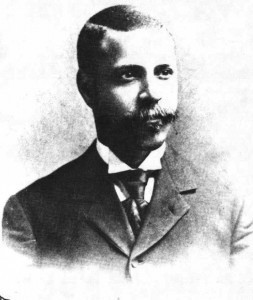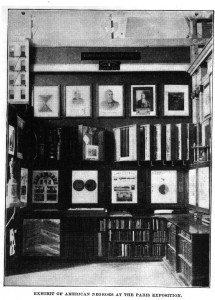Collection Connections: “Twelve Years a Slave”
(The following is a guest post by Cheryl Fox, Library of Congress Archives collection specialist in the Manuscript Division.)

Daniel A. P. Murray (1852 -1925). Photographer unknown. Photograph, undated.
Solomon Northup’s account of his kidnapping in Washington, D.C., sale to a plantation owner in Louisiana and subsequent escape was first published in 1853, the year he regained his freedom. The Library of Congress Rare Book and Special Collections Division holds an 1859 edition of “Twelve Years a Slave,” which you can read about in this previous blog post.
Daniel A. P. Murray included the book in his 1900 bibliography, – a project he produced while working at the Library of Congress.
Murray, born in 1852 in Baltimore, worked at the Library from 1871 to 1925. U.S. Special Agent on Negro Education Thomas J. Calloway contacted then Librarian of Congress Herbert Putnam in January 1900 to request books or pamphlets written by African American authors for a display at the upcoming Exposition Universelle in Paris. Within a few months, Murray had compiled a preliminary list of 300 works. He credited former Librarian of Congress Ainsworth Spofford’s “amazing foresight” in collecting many of the books and pamphlets he found in the Library’s collection.
Murray also appealed to the public by traveling to African American communities, including Baltimore and Philadelphia, to find more books. He composed a letter that was printed and widely circulated, requesting materials or information that could be sent to the Library at no postage charge.
Murray’s list grew to 1,100 titles and became the core of the Library’s “Colored Authors’ Collection.”

Exhibit of American Negroes at the Paris Exposition. Photographer unknown. Photograph undated, in Review of Reviews, vol. 22.
The Paris Exposition attracted more than 48 million visitors. Murray’s bibliography and several hundred books in the Palace of Social Economy were part of an exhibit curated by W.E.B. DuBois, “The American Negro.” Read more about the exhibit here.
W.E.B. DuBois paid special attention to Murray’s work in his description of the exhibit:
“Perhaps the most unique and striking exhibit is that of American Negro literature. The development of Negro thought – the view of themselves which these millions of freedmen have taken – is of intense psychological and practical interest. There are many who have scarcely heard of a Negro book, much less read one; still here is a bibliography made by the Library of Congress containing 1,400 titles of works written by Negroes; 200 of these books are exhibited on the shelves.” (Du Bois, W.E. Burghardt. 1900. “The American Negro at Paris.” The American Monthly Review of Reviews, vol.XXII, no.5 (November): pp.575-577. )
Judges for the Paris Exposition awarded the American Negro exhibit several medals; by popular demand, it was immediately sent on to the 1901 Pan American Exposition in Buffalo, N.Y.
After the Paris Exposition, the works collected by Murray and displayed in the exhibition were placed in the Library. At his death in 1925, Murray bequeathed his personal library of more than 1,400 volumes and pamphlets to the Library as well. The resulting collection of materials, many of them unique, provides a rich catalog of information on African-American life around the turn of the century.
In addition to the books and pamphlets Murray collected, portions of the “American Negro” exhibit W.E.B. Du Bois and special agent Thomas J. Calloway compiled are housed in the Prints and Photographs Division. A description of these materials is found here.
Library of Congress's Blog
- Library of Congress's profile
- 74 followers



